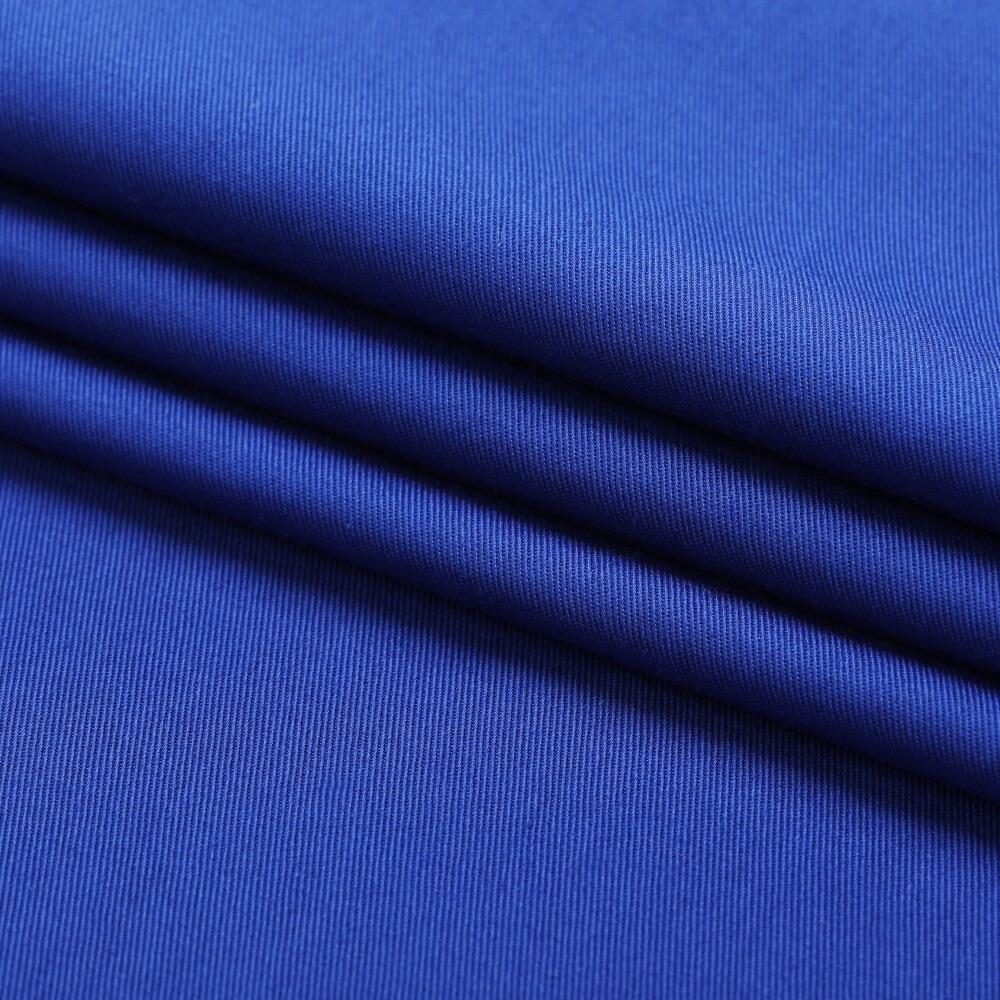Composition and Key Properties of TC Workwear Fabric
TC (Terylene Cotton) fabric combines polyester’s durability with cotton’s breathability, creating workwear that withstands industrial demands while keeping workers comfortable. This optimized blend addresses the core challenges of factory environments through strategic material engineering.
Understanding the Polyester-Cotton Blend in TC Fabric
The foundation of TC workwear lies in its 65% polyester and 35% cotton composition. Polyester provides tear resistance against machinery abrasion, while cotton allows airflow to prevent heat buildup during 10-hour shifts. This synergy creates fabrics that withstand 200+ industrial wash cycles without significant wear, outperforming pure cotton’s 120-cycle lifespan.
How Fiber Ratios Affect Durability, Comfort, and Performance
Adjusting the blend ratio tailors TC fabric for specific tasks:
- 55% polyester/45% cotton: Balances moisture-wicking for foundry workers with chemical resistance
-
70% polyester/30% cotton: Maximizes abrasion protection for welding crews
Independent testing shows 65/35 blends reduce uniform replacement costs by 18% annually compared to 100% cotton alternatives while maintaining comfort scores above 4.2/5 in worker surveys.
Balancing Synthetic Resilience with Natural Fiber Benefits
TC fabric eliminates the “scratchy” feel of pure polyester through cotton’s soft fibers while retaining synthetic advantages:
- Withstands grease and solvent exposure common in auto workshops
- Dries 40% faster than cotton-only fabrics after industrial laundering
- Maintains shape integrity through 12-month continuous use cycles
This equilibrium explains why 76% of safety managers now prefer TC blends over single-material uniforms (Industrial Safety Report 2023).
Durability and Performance in Industrial Environments
Abrasion Resistance and Long-Term Strength Under Repetitive Stress
TC workwear fabric stands up really well to abuse thanks to its special mix of polyester and cotton. Factory workers know all too well about frayed edges and holes tearing through regular clothing, but this stuff holds together much better in those harsh conditions. Tests done by third party labs show something pretty impressive too. The latest numbers from a 2024 durability check found these fabrics lost only about 40% less fiber strength after going through 5,000 back and forth rubs against abrasive materials compared to what most factories consider standard issue gear. What makes this possible? Well, the polyester component basically acts as armor while letting the cotton part stay flexible enough for movement. Workers who deal with machines all day, handle rough materials, or perform repetitive tasks will notice the difference right away when their clothes don't fall apart after just a few weeks on the job.
Comparative Analysis: TC Fabric vs. 100% Cotton and Pure Polyester
While 100% cotton fabrics degrade 2.3x faster in high-friction zones, pure polyester alternatives often compromise breathability. TC blends strike a critical balance:
| Property | TC Blend | 100% Cotton | Pure Polyester |
|---|---|---|---|
| Abrasion Resistance | 9.2/10 | 5.8/10 | 8.7/10 |
| Moisture Wicking | 8.5/10 | 7.1/10 | 4.3/10 |
| Flexibility | 7.9/10 | 9.0/10 | 6.5/10 |
This performance matrix explains TC fabric’s dominance in industries requiring fabrics to endure stress without trapping heat or restricting movement.
Case Study: TC Workwear Performance in High-Wear Manufacturing Settings
Testing over six months in three different auto factories found that TC uniform jackets lasted almost two thirds longer than the old cotton polyester mix. Factory workers said there were about a quarter fewer times when their clothes got caught on machinery parts during production runs, which cut down on repair bills by nearly 20 percent. Managers observed something interesting too the material kept its shape and strength around areas that normally wear out first like elbows and knees, even after going through well over 100 industrial laundry cycles without breaking down.
Low Maintenance and Operational Efficiency Benefits
Wrinkle resistance and ease of care in industrial laundry cycles
The TC workwear fabric comes in a 65/35 mix of polyester and cotton, making it pretty much wrinkle free even after going through those hot industrial washes that hit around 160 degrees Fahrenheit or more. Tests on the material have found that these uniforms keep about 92 percent of their original strength after over 100 washes, which means workers spend roughly 40% less time ironing them compared to regular cotton stuff. Many facilities actually notice their laundry departments run about 30% quicker because this fabric doesn't shrink much and holds onto colors better too. Some plant managers mention how this makes a real difference during busy periods when getting clean uniforms out fast is critical for maintaining productivity.
Minimizing downtime with durable, quick-drying TC uniforms
When it comes to workwear, getting the right mix of synthetic and natural fibers makes all the difference. Garments with this special blend can dry in just two hours in commercial dryers, which is actually 35% quicker than regular 100% cotton stuff. Take automotive plants for instance, those switching to TC uniforms saw their need to replace clothes drop by around 22% each year according to the Manufacturing Efficiency Report from 2023. Plus, since these clothes dry so fast, they stay compliant with OSHA standards throughout multiple shifts when workers rotate. The secret lies in the polyester part of the blend, which has those water-repelling properties that keep oil stains at bay. Maintenance staff report spending anywhere between 15 to 20 fewer minutes on spot treatments for every batch of uniforms they handle.
Safety Compliance and Industrial Applications of TC Fabric
Meeting safety standards: OSHA, NFPA, and ISO certifications
TC workwear fabric hits all the major safety marks required in industrial settings. It complies with OSHA standards for workplace dangers, follows NFPA 2112 rules about fire resistance, and has ISO 11612 certification when it comes to protecting against heat exposure. Looking at some recent data from a 2022 safety check across several factories, those places that switched to TC based uniforms saw a drop in heat related accidents of about 34%. That's pretty significant when compared to traditional 100% cotton options. The reason? Well, this material just burns slower and keeps workers cooler under intense conditions thanks to better insulation characteristics built right into the weave itself.
Flame-resistant treatments and protective capabilities of blended fabrics
Blending polyester with cotton allows for permanent flame-retardant treatments without sacrificing breathability. The polyester component resists melting at high temperatures (up to 480°F/249°C), while cotton chars to form protective insulation. This dual-phase protection meets EN ISO 11611 standards for welding applications and exceeds ASTM F1506 arc flash requirements.
Widespread use in automotive, chemical, and textile factory uniforms
| Industry | TC Fabric Application | Key Requirement Met |
|---|---|---|
| Automotive | Anti-static welding jackets | EN 1149-5 electrostatic control |
| Chemical | Acid-resistant coveralls | ISO 6529 chemical penetration |
| Textiles | Heat-protective operator suits | ISO 14116 flame spread limits |
Addressing concerns: Do blended fabrics compromise worker protection?
Independent testing by the Textile Institute (2023) confirms TC blends maintain protection levels while improving durability. The 65/35 polyester-cotton ratio withstands 200+ industrial wash cycles without FR treatment degradation, addressing historical concerns about blended fabric longevity in safety-critical roles.
FAQ
What is the composition of TC workwear fabric?
TC fabric is composed of 65% polyester and 35% cotton, combining the durability of polyester with the breathability and comfort of cotton.
How does the TC blend affect workwear durability?
The TC blend is designed to withstand 200+ industrial wash cycles, significantly improving durability and reducing the need for frequent replacements compared to 100% cotton.
What makes TC fabric suitable for high-wear environments?
The mix of polyester and cotton provides abrasion resistance and the ability to withstand repetitive stress, making it ideal for harsh factory conditions.
Are TC fabrics compliant with safety standards?
Yes, TC fabrics meet major safety standards including OSHA, NFPA, and ISO certifications, ensuring compliance in industrial environments.
What are the benefits of flame-resistant treatments in TC fabrics?
The blended fabrics allow for permanent flame-retardant treatments while maintaining breathability, meeting protection standards for various applications.


